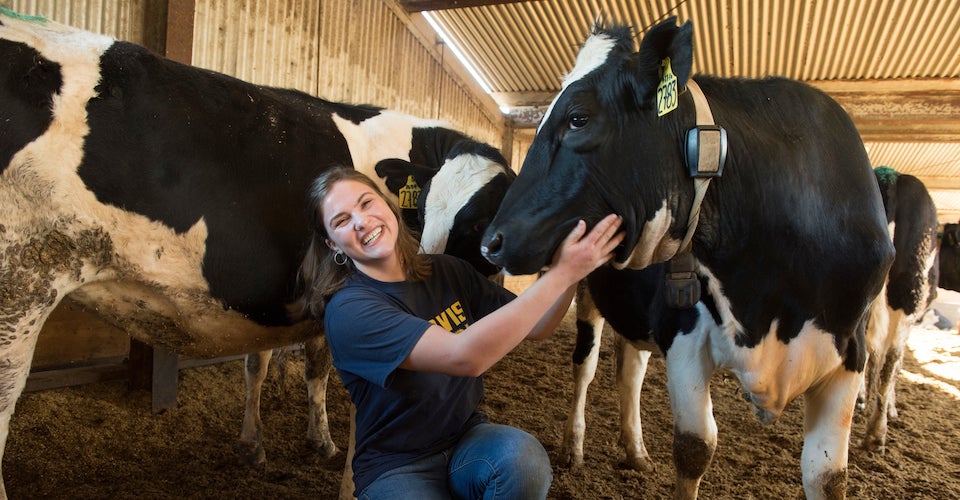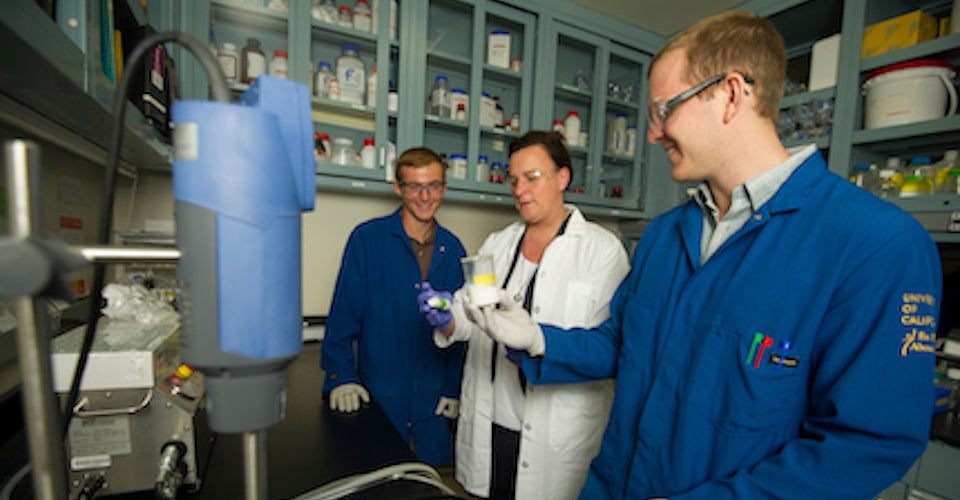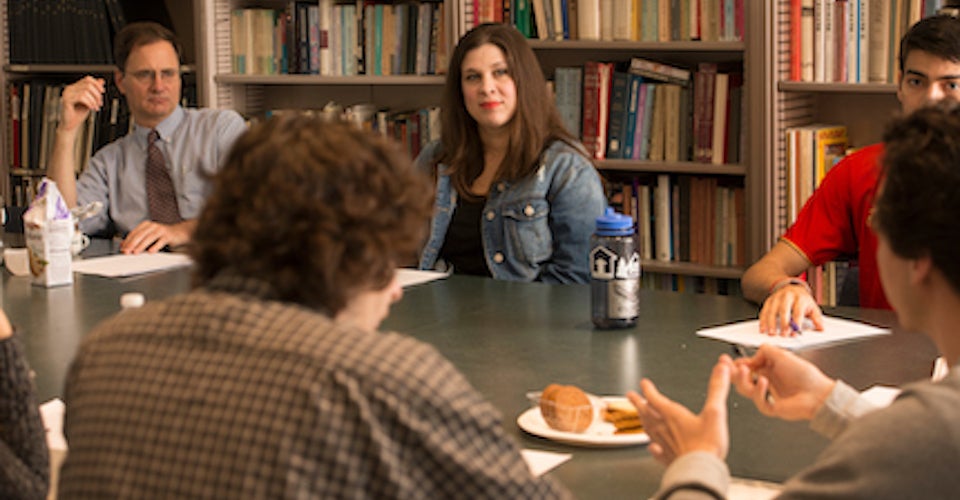UC Davis is the best for reasons you may already know — our world-leading veterinary medicine and agriculture programs, for starters — and plenty of reasons you might not. For example, have you heard that we're No. 1 in the U.S. for campus sustainability? Or that we're the No. 1 Most Important School for Women in STEM?
And we don't just excel in the sciences. UC Davis is also top ranked in multiple areas, from innovation to English and art.
Read on to find out what makes us a top school in so many areas.
1. Veterinary Medicine

UC Davis School of Veterinary Medicine is ranked No. 1 in the world by QS World University Rankings, and No. 1 in the nation by U.S. News & World Report.
Yes, our accolades are a result of the Vet School’s research funding — $77.3 million in the fiscal year 2017-18. But we also earned them because of the far-reaching impact of that research.
“We’re able to do revolutionary treatments that can impact human medicine as well,” said Tom Hinds, director of strategic planning and communications at the UC Davis School of Veterinary Medicine.
Two recent examples:
- Jonna Mazet, executive director of the One Health Institute, is fighting against pandemics in her Global Virome Project, and her group has identified a new ebola virus in bats in Sierra Leone.
- Veterinarian Jamie Peyton has helped to heal animals burned from California wildfires with fish-skin bandages — the first use of the innovation for nonhuman patients.
2. Agriculture

Agriculture at UC Davis ranks No. 1 nationally and No. 2 internationally, according to U.S. News & World Report and QS World University Rankings, respectively.
And why is that?
- The impacts of UC Davis’ agricultural research are felt globally.
- California is the largest supplier of food in the nation, and UC Davis works on solutions to improve its farms.
- As a land-grant university, UC Davis works with California stakeholders, giving them the research to back their policy decisions.
- The campus boasts 5,300 acres of land, 2,300 of those dedicated to ag.
- Beyond ag, UC Davis is a leader in bridging the gap between agriculture and the environment. We’ve received $181 million in funding for agricultural, environmental and human and social science research.
3. Campus Sustainability

UC Davis’ campus sustainability is No. 1 in the nation for a reason. Actually, many reasons. Even though our campus continues to add more students, staff and buildings, carbon output here is on the decline. The goal is to be carbon neutral by 2025, but we might get there even sooner, said Katie Hetrick, senior communication manager with Finance, Operations and Administration.
We also have:
- Green housing. Our Tercero 3 residence halls have received the highest rating for sustainability from LEED.
- Repurposed waste. A biodigester on campus turns waste from dining halls and animal facilities into clean energy.
- Green buildings. About 25 of UC Davis’ buildings have green-building certifications from LEED.
- Sustainable transportation. Only one in four people drive by themselves to UC Davis. That’s partly because we’re one of the most bike-friendly campuses. We’ve been named a Platinum Bicycle Friendly University by the League of American Bicyclists.
4. Women in STEM

That women are underrepresented in STEM fields is no secret. UC Davis is working to combat that trend.
Our campus is the No. 1 Most Important School for Women in STEM, according to Forbes. The business publication took its list of best value colleges, then filtered for STEM-specializing schools as well as the rate of women’s attendance. UC Davis landed on top during Forbes’ last ranking (in 2016) with 26 percent of students specializing in STEM and 56 percent female enrollment overall.
Our commitment to women in STEM runs deeper than statistics. UC Davis has mentorship programs for women, implicit bias training for faculty search committees and support for working mothers. We received the 2016 Million Women Mentors’ Higher Institution of the Year for leadership and dedication to the mission of mentoring women in STEM.
5. Evolution and Ecology

Our Evolution and Ecology graduate program ranks No. 2 — nationally.
That’s partly because of the sheer number of faculty and programs in ecology, said Jay Stachowicz, chair of evolution and ecology. His department has 28 faculty members. When combined with other graduate groups, he counts well over 100 faculty across graduate groups in ecology, population biology and related disciplines.
What’s more, the department truly takes on the linkage between ecology and evolution.
“The ‘and’ actually means ‘and’ and not just ‘comma,’” Stachowicz said.
6. Innovation

Our strengths don’t remain in silos. UC Davis was also named No. 2 “Most Innovative” among California public schools by U.S. News & World Report.
College officials identified schools with “the most innovative improvements in terms of curriculum, faculty, students, campus life, technology or facilities.”
UC Davis was named because of our emphasis on sustainable campus planning and our 5,300 acres with about 1,000 buildings that serve more than 36,000 students. We also offer 100 majors and counting, with new interdisciplinary programs created all the time.
7. Biological and Agricultural Engineering

Our biological and agricultural engineering graduate program ranks No. 1 in California in U.S. News & World Report.
Founded in 1915, the department has a storied history:
- UC Davis’ roots go back to our agricultural engineering department serving as the “farm” for UC Berkeley.
- Faculty work on crucial solutions like feeding a population of 9 billion and creating renewable energy from trash.
- Their research improves farming techniques and agricultural yields around the world.
- The size of the department — currently, 61 grad students and 15 faculty — lends itself to a collaborative environment. Students say they appreciate the personal attention they get from professors.
8. Fine Arts

Our art studio graduate program ranks No. 3 among California public schools, according to U.S. News & World Report.
The university has a history of pioneering in the arts. In the 1960s, it was home to the funk movement in ceramics and cutting-edge faculty members Robert Arneson, Wayne Thiebaud, William T. Wiley and Roy De Forest.
That legacy lives on in TB9, the corrugated metal building for ceramics that was meant to be temporary and now sits on the National Register of Historic Places. The art studio department continues to encourage creative experimentation and cross pollination between disciplines with facilities for drawing, ceramic sculpture, painting, photography, printmaking, video and sculpture.
9. History

Our history graduate program ranks No. 3 among California public colleges in U.S. News & World Report.
In 2018, more than 20 of its faculty members and graduate students won prizes or fellowships, including American Council of Learned Societies fellowships, the Bancroft Prize and a National Endowment for the Humanities fellowship.
Areas of strength include modern U.S. history, Latin American history, women's and gender history, the history of coercive labor systems, the history of the American West and Middle East/North African history.
10. English

Our English graduate program ranks No. 4 among those at California public universities, and No. 20 overall, according to U.S. News & World Report.
The department stands out because of its cross-disciplinary research and teaching, said Gina Bloom, interim chair of English. The 30 faculty members are affiliated with multiple graduate programs, including critical theory, performance studies, religious studies, cultural studies and education.
They're also distinguished. Two faculty members have been elected to the National Academy of the Arts. Recent fellowships have come from the Guggenheim, the Mellon Foundation, the National Endowment for the Humanities and the American Council for Learned Societies.
11. Top 3 Among California Public Colleges

That’s right. Out of all California public colleges, UC Davis ranks No. 3 according to Times Higher Education World University Rankings, Washington Monthly and Round University Ranking.
So we don’t just excel in one — or 10 — areas. All around, UC Davis is a high-caliber university for any of the 100-plus majors we offer.